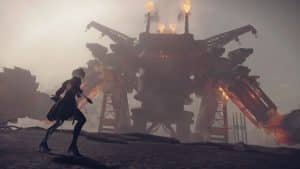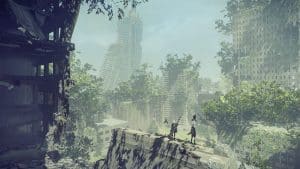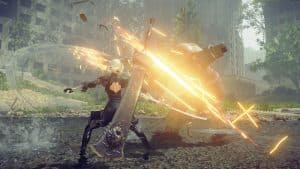NieR: Automata
Related Games
Description
🔥 What is NieR: Automata for PC?
NieR: Automata is an action role-playing game developed by PlatinumGames and published by Square Enix, blending intense combat mechanics with profound philosophical storytelling. Set in a distant future where humanity has been driven to the moon by invading alien machines, the game follows a group of androids sent to reclaim Earth from mechanical lifeforms. It is a spiritual successor to the cult classic NieR, known for its emotional depth, unpredictable narrative structure, and hauntingly beautiful world.
Players primarily control 2B, a combat android from the YoRHa unit, alongside her reconnaissance partner 9S and the enigmatic fighter A2. The story unfolds through multiple playthroughs that reveal hidden perspectives, alternate timelines, and deep metaphysical questions about existence, consciousness, and purpose. NieR: Automata is not just an action game it’s an experience that challenges players to reflect on what it means to be human, even in a world devoid of humanity.
With its seamless mix of bullet-hell combat, open-world exploration, and existential narrative, the game became one of the most critically acclaimed titles of its generation. Its combination of melancholy storytelling, powerful music, and inventive gameplay systems makes it stand out as one of the most emotionally resonant games ever made.
👉 Features of NieR: Automata
Dynamic and Fast-Paced Combat
NieR: Automata delivers a thrilling blend of hack-and-slash action and bullet-hell mechanics that feel uniquely fluid and responsive. Players can perform acrobatic attacks, swap between weapons mid-combo, and use their Pod companion for ranged support. The battle system rewards both skill and experimentation, as each weapon type swords, spears, bracers offers a distinct rhythm and feel.
The combat also evolves through upgrades and chip-based enhancements that let players customize their androids’ stats and abilities. This system, while flexible, never becomes overcomplicated, maintaining a perfect balance between depth and accessibility.
Multiple Playthroughs and Layered Storytelling
Unlike most RPGs, NieR: Automata reveals its full story only after multiple playthroughs, each offering a radically different perspective. What begins as a simple war between androids and machines gradually transforms into a haunting meditation on memory, choice, and the illusion of free will.
Subsequent routes introduce new protagonists, alternate events, and even shifts in genre from action adventure to visual novel segments all interwoven to form a unified narrative tapestry that rewards patience and curiosity.
Philosophical Themes and Emotional Writing
The game’s writing blends science fiction with philosophy, drawing inspiration from thinkers like Pascal, Nietzsche, and Sartre. Every character, from a battle-hardened android to a childlike machine, embodies a different existential dilemma.
NieR: Automata constantly questions the player’s role, morality, and the meaning of suffering, often through subtle moments rather than heavy exposition. Its emotional weight is amplified by quiet gestures, tragic choices, and the eerie familiarity of a world both dead and alive.
Expansive World Design
The world of NieR: Automata is a sprawling wasteland of beauty and decay, stretching across deserts, ruins, and abandoned cities reclaimed by nature. Each area feels alive despite the absence of humans, filled with secrets, side quests, and environmental storytelling.
Fast travel and dynamic movement make exploration intuitive, while atmospheric lighting and ambient soundscapes turn even mundane journeys into moments of reflection and melancholy.
Unforgettable Soundtrack
Composer Keiichi Okabe’s score is one of the most celebrated in gaming, seamlessly blending orchestral, choral, and electronic elements. Every track feels emotionally tailored to its moment, whether you’re fighting a colossal boss or wandering through a silent forest.
The music changes dynamically depending on context, intensifying battles or softening during quiet interludes. It’s a soundtrack that lingers long after the credits roll, often revisited by players who simply want to feel the emotion again.
Gameplay
Combat Fluidity and Customization
NieR: Automata’s combat is fast, responsive, and elegantly choreographed. Players can chain together melee attacks, air combos, dodges, and ranged fire in a continuous flow of movement. The animations are beautifully synchronized, giving each encounter a cinematic quality.
Customization comes through the plug-in chip system, which allows players to install upgrades that enhance abilities or change gameplay mechanics. Some chips boost attack power, while others modify the HUD or even grant auto-healing. This modular system provides endless room for experimentation, letting players shape their android’s fighting style to their liking.
Open World Exploration and Quests
The open world offers freedom without overwhelming the player. While the main story has urgency, there’s always time to explore hidden areas, complete side quests, and uncover lore. Many side missions aren’t just filler they reveal heartbreaking stories about the machines and the forgotten remnants of humanity.
Traversal feels smooth thanks to responsive movement and a fluid camera. You can glide across rooftops, leap over ruins, and discover environmental puzzles that reveal snippets of forgotten history. These small discoveries make exploration deeply satisfying.
Multiple Endings and Narrative Experimentation
The structure of NieR: Automata is daring, presenting over twenty endings some comedic, some devastating, and a few profoundly meaningful. The main routes (A through E) serve as the true progression of the narrative, each deepening your understanding of the world and its characters.
The final ending delivers a meta-narrative twist that breaks the fourth wall in an emotionally powerful way, turning the player’s own data into an instrument of sacrifice and connection. It’s one of the most memorable conclusions in gaming, both conceptually and emotionally.
Graphics
Minimalist yet Emotional Visual Design
NieR: Automata’s visuals aren’t about photorealism but about mood, contrast, and atmosphere. The muted color palette, weathered architecture, and ethereal lighting create a dreamlike sense of beauty amid desolation.
Every location tells a story through decay an amusement park run by forgotten machines, a forest overtaken by rusting knights, a factory that hums with artificial life. The game’s understated aesthetic enhances its themes of transience and loss.
Smooth Animation and Technical Performance
Character animations are fluid and precise, making even ordinary combat encounters visually striking. The seamless transition between gameplay and cutscenes enhances immersion and emphasizes PlatinumGames’ trademark polish.
The PC version offers adjustable graphics settings and runs smoothly on a wide range of hardware, though early versions had optimization issues that were later patched. At its best, the game maintains stable performance while preserving artistic fidelity.
Cinematic Presentation and Camera Work
The camera dynamically shifts during gameplay, switching between 3D action, 2.5D platforming, and top-down shooting sequences. These transitions are not just stylistic they serve narrative rhythm and variety, keeping gameplay fresh.
Cinematic camera angles heighten emotional scenes, while minimalist UI elements keep focus on the world and its characters. The game’s presentation feels intentional, almost like an interactive film, where every frame is carefully composed.
Pros and Cons
✔️ Pros
- Deep, thought-provoking story with multiple layers of meaning
- Fluid and responsive combat system with rich customization options
- Hauntingly beautiful soundtrack that elevates every emotional beat
- Rich environmental storytelling and memorable side quests
- Unique narrative structure that redefines how stories can be told in games
❌ Cons
- Some areas and side quests can feel repetitive over time
- Occasional pacing issues between playthroughs may frustrate impatient players
- Early PC port performance required patches to reach full stability
ℹ️ Game information
⭐ Installation Instructions
- The game is fully complete, you just need to install it, so there is no need to unpack it or download it from other sources.
- Just run the NieR: Automata.exe installation file.
- Simply launch the game from shortcut desktop.
⚙️ System Requirements
✅ Minimum:
- OS: Windows 7/8.1/10 64bit
- Processor: Intel Core i3 2100 / AMD A8-6500
- Memory: 4 GB RAM
- Graphics: NVIDIA GeForce GTX 770 VRAM 2GB / AMD Radeon R9 270X VRAM 2GB
- DirectX: Version 11
- Network: Broadband Internet connection
- Storage: 50 GB available space
✅ Recommended:
- OS: Windows 8.1/10 64bit
- Processor: Intel Core i5 4670 / AMD A10-7850K
- Memory: 8 GB RAM
- Graphics: NVIDIA GeForce GTX 980 VRAM 4GB / AMD Radeon R9 380X VRAM 4GB
- DirectX: Version 11
- Network: Broadband Internet connection
- Storage: 50 GB available space
Images









